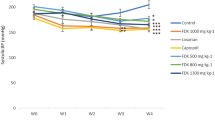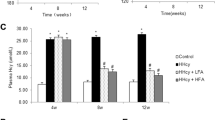Abstract
In spontaneously hypertensive rats (SHRs) excess endogenous aldehydes bind sulfhydryl groups of membrane proteins, altering membrane Ca2+ channels and increasing cytosolic free calcium and blood pressure. The thiol compound, N-acetyl cysteine, normalizes elevated blood pressure in SHRs by binding excess endogenous aldehydes. Vitamin E increases tissue glutathione levels – a storage form of cysteine. The aim of the present study was to investigate whether a dietary supplementation of vitamin E lowers blood pressure and prevents renal vascular changes by normalizing tissue aldehyde conjugates and cytosolic [Ca2+] in SHRs. Starting at 12 weeks of age, animals were divided into three groups of six animals each. Animals in the WKY-control group and SHR-control group were given a normal diet and the SHR-vitamin E group a diet supplemented with vitamin E (34 mg/kg feed) for the next 9 weeks. After 9 weeks, systolic blood pressure, platelet [Ca2+]i, and liver, kidney and aortic aldehyde conjugates were significantly higher in SHR controls as compared to WKY controls and the SHR-vitamin E group. SHR-controls also showed smooth muscle cell hyperplasia in the small arteries and arterioles of the kidney. Dietary vitamin E supplementation in SHRs lowered the systolic blood pressure, cytosolic [Ca2+], tissue aldehyde conjugates and attenuated adverse renal vascular changes.
Similar content being viewed by others
References
Tappel AL: Biological antioxidant protection against lipid peroxidation damage. Am J Clin Nutr 23: 1137–1139, 1970
Burton GW, Foster DO, Perly B, Slater TF, Smith ICP, Ingold KU: Biological antioxidants. Philos Trans R Soc Lond [Biol] 311: 565-578, 1985
Beamish RE: Vitamin E – then and now. Can J Cardiol 9: 29–30, 1993
Gey KF, Puska P, Jordan P, Moser UK: Inverse correlation between plasma vitamin E and mortality from ischemic heart disease in cross-cultural epidemiology. Am J Clin Nutr 53: 326S-334S, 1991
Donnan PT, Thomson M, Fowkes FGR, Prescott RJ, Housley E: Diet as a risk factor for peripheral arterial disease in the general population: The Edinburgh artery study. Am J Clin Nutr 57: 917-921, 1993
Costagliola C, Libondi T, Menzione M, Rinaldi E, Auricchio G: Vitamin E and red blood cell glutathione. Metabolism 34: 712-714, 1985
Sharma A, Kharb S, Chugh SN, Kakkar R, Singh GP: Evaluation of oxidative stress before and after control of glycemia and after vitamin E supplementation in diabetic patients. Metabolism 49: 160–162, 2000
Paolisso G, D'Amore A, Giugliano D, Ceriello A, Varricchio M, D'Onofrio F: Pharmacologic doses of vitamin E improve insulin action in healthy subjects and non-insulin-dependent diabetic patients. Am J Clin Nutr 57: 650–656, 1993
Barbagallo M, Dominguez LJ, Tagliamonte MR, Resnick LM, Paolisso G: Effect of vitamin E and glutathione on glucose metabolism. Role of magnesium. Hypertension 34: 1002–1006, 1999
Raghuveer G, Sinkey CA, Chenard C, Stumbo P, Haynes WG: Effect of vitamin E on resistance vessel endothelial dysfunction induced by methionine. Am J Cardiol 88: 285–290, 2001
Newaz MA, Nawal NNA: Effect of α-tocopherol on lipid peroxidation and total antioxidant status in spontaneously hypertensive rats. Am J Hypertens 11: 1480–1485, 1998
Galley HF, Thornton J, Howdle PD, Walker BE, Webster NR: Combination oral antioxidant supplementation reduces blood pressure. Clin Sci 92: 361–365, 1997
Lieber CS: Mechanism of ethanol induced hepatic injury. Pharmacol Ther 46: 1–41, 1990
Sorrell MD, Ruma DJ: The functional implications of acetaldehyde binding to cell constituents. Ann NY Acad Sci 492: 50–70, 1987
Vasdev S, Barrett B, Longerich L, Ford CA: Ethanol-induced hypertension: The role of acetaldehyde. In: N.S. Dhalla (ed). Pathophysiology of Heart Failure. Kluwer Academic Publishers, Norwell, MA, pp 77–93, 1996
Vasdev S, Longerich L, Ford CA: Role of aldehydes in hypertension. In: B.K. Sharma, N. Takeda, N.K. Ganguly, P.K. Singal (eds). Adaptation Biology and Medicine (Vol. I). Narosa Publishing House, New Delhi, pp 326–339, 1997
Vasdev S, Mian T, Ford CA, Longerich L, Parai S: Role of endogenous aldehydes in spontaneously hypertensive and disulfiraminduced hypertensive rats. Nutr Metab Cardiovasc Dis 6: 130–140, 1996
Kumar KV, Das UN: Are free radicals involved in the pathobiology of human essential hypertension? Free Rad Res Commun 19: 59–66, 1993
Wen Y, Killalea S, McGettigan P, Feely J: Lipid peroxidation and antioxidant vitamins C and E in hypertensive patients. Irish J Med Sci 165: 210–212, 1996
Bendich A, Gabriel E, Machlin LJ: Differences in vitamin E levels in tissues of the spontaneously hypertensive and Wistar–Kyoto rats (41560). Proc Soc Exp Biol Med 172: 297–300, 1983
Ito H, Torii M, Suzuki T: A comparative study on defense systems for lipid peroxidation by free radicals in spontaneously hypertensive and normotensive rat myocardium. Comp Biochem Physiol 13B: 37–40, 1992
Dillard CJ, Tappel AL: Fluorescent damage products of lipid peroxidation. Meth Enzymol 105: 337–341, 1984
Mandal AK, Bell RD, Parker D, Nordquist JA, Lindeman RD: An analysis of the relationship of the malignant lesions of the kidney to hypertension. Microvas Res 14: 279–292, 1977
Franco-Obregón A, Ureña J, Lòpez-Barneo J: Oxygen-sensitive calcium channels in vascular smooth muscle and their possible role in hypoxic arterial relaxation. Proc Natl Acad Sci 92: 4715-4719, 1995
Murphy BJ, Washkurak AW, Tuana BS: Dihydropyridine binding to the L-type Ca2+ channel in rabbit heart sarcolemma and skeletal muscle transverse-tubules: Role of disulfide, sulfhydryl and phosphate groups. Biochim Biophys Acta 1052: 333–339, 1990
Zaidi NF, Lagenaur CF, Abramson JJ, Pessah I, Salama G: Reactive disulfides trigger Ca2+ release from sarcoplasmic reticulum via an oxidation reaction. J Biol Chem 264: 21725–21736, 1989
Oba T, Yamaguchi M: Sulfhydryls on frog skeletal muscle membrane participate in contraction. Am J Physiol 259: C709–C714, 1990
Schauenstein E, Esterbauer H, Zollner H: Aldehydes in biological systems. In: J.R. Lagnado (ed). Aldehydes in Biological Systems, their Natural Occurrence and Biological Activities. Pion, London pp 1–7, 1977
Bolli P, Erne P, Hulthen UL, Ritz R, Kiowski W, Ji BH, Buhler FR: Parallel reduction of calcium-influx-dependent vasoconstriction and platelet-free calcium concentration with calcium entry and β-adrenoceptor blockade. J Cardiovasc Pharmac 6: S996-S1001, 1984
Pollard TD: Electron microscopy of synthetic myosin filaments. J Cell Biol 67: 93–104, 1975
Vasdev S, Ford CA, Longerich L, Gadag V, Wadhawan S: Role of aldehydes in fructose induced hypertension. Mol Cell Biochem 181: 1–9, 1998
Vasdev S, Ford CA, Longerich L, Parai S, Gadag V, Wadhawan S: Aldehyde induced hypertension in rats: Prevention by N-acetyl cysteine. Artery 23: 10–36, 1998
Meister A, Anderson ME, Hwang O: Intracellular cysteine and glutathione delivery systems. J Am Col Nut 5: 137–151, 1986
Thornalley PJ: Modification of the glyoxalase system in disease processes and prospects for therapeutic strategies. Biochem Soc Trans 21: 531–534, 1993
Phillips SA, Mirlees D, Thornalley PJ: Modification of the glyoxalase system in streptozotocin-induced diabetic rats. Pharmacology 46: 805–811, 1993
Janero DR, Burghardt B: Cardiac membrane vitamin E and malondialdehyde levels in heart muscle of normotensive and spontaneously hypertensive rats. Lipids 24: 33–38, 1989
Uysal M, Bulur H, Sener D, Öz H: Lipid peroxidation in patients with essential hypertension. Int J Clin Pharmacol Ther Toxicol 24: 474–476, 1986
Sprince H, Parker CM, Smith GG, Gonzales LJ: Protection against acetaldehyde toxicity in the rat by L-cysteine, thiamin and L-2-methylthiazolidine-4-carboxylic acid. Agents Actions 4: 125–129, 1974
Poli G, Dianzani MU, Cheeseman KH, Slater TF, Lang J, Esterbauer H: Separation and characterization of the aldehyde products of lipid peroxidation stimulated by carbon tetrachloride or ADP-iron in isolated rat hepatocytes and rat liver microsomal suspensions. Biochem J 227: 629–638, 1985
Dargel R: Lipid peroxidation – a common pathogenic mechanism? Exp Toxicol Pathol 44: 169–181, 1992
Newaz MA, Nawal NNA, Rohaizan CH, Muslim N, Gapor A: α-Tocopherol increased nitric oxide synthase activity in blood vessels of spontaneously hypertensive rats. Am J Hypertens 12: 839–844, 1999
Szczeklik A, Gryglewski RJ, Domagala R, Basista M: Dietary supplementation with vitamin E in hyperlipoproteinemias: Effects on plasma lipid peroxides, antioxidant activity, prostacyclin generation and platelet aggregability. Thromb Haemostasis 52: 425-430, 1985
Reaven GM, Hoffman BB: Abnormalities of carbohydrate metabolism may play a role in the etiology and clinical course of hypertension. Trends Pharmacol Sci 9: 78–79, 1998
Hulman S, Falkner B, Freyvogel N: Insulin resistance in the conscious spontaneously hypertensive rat: Euglycemic hyperinsulinemic clamp study. Metabolism 42: 14–18, 1993
Zemel MB, Reddy S, Sowers JR: Insulin attenuation of vasoconstriction responses to phenylephrine in zucker lean and obese rats. Am J Hypertens 4: 537–539, 1991
Swislocki A, Tsuzuki A: Insulin resistance and hypertension: Glucose intolerance, hyperinsulinemia, and elevated free fatty acids in the lean spontaneously hypertensive rat. Am J Med Sci 306: 282–286, 1993
Vasdev S, Ford CA, Parai S, Longerich L, Gadag V: Dietary vitamin C supplementation lowers blood pressure in spontaneously hypertensive rats. Mol Cell Biochem 218: 97–103, 2001
Vaziri ND, Wang XQ, Oveisi F, Rad B: Induction of oxidative stress by glutathione depletion causes severe hypertension in normal rats. Hypertension 36: 142–146, 2000
Author information
Authors and Affiliations
Rights and permissions
About this article
Cite this article
Vasdev, S., Gill, V., Parai, S. et al. Dietary vitamin E supplementation lowers blood pressure in spontaneously hypertensive rats. Mol Cell Biochem 238, 111–117 (2002). https://doi.org/10.1023/A:1019915306581
Issue Date:
DOI: https://doi.org/10.1023/A:1019915306581




